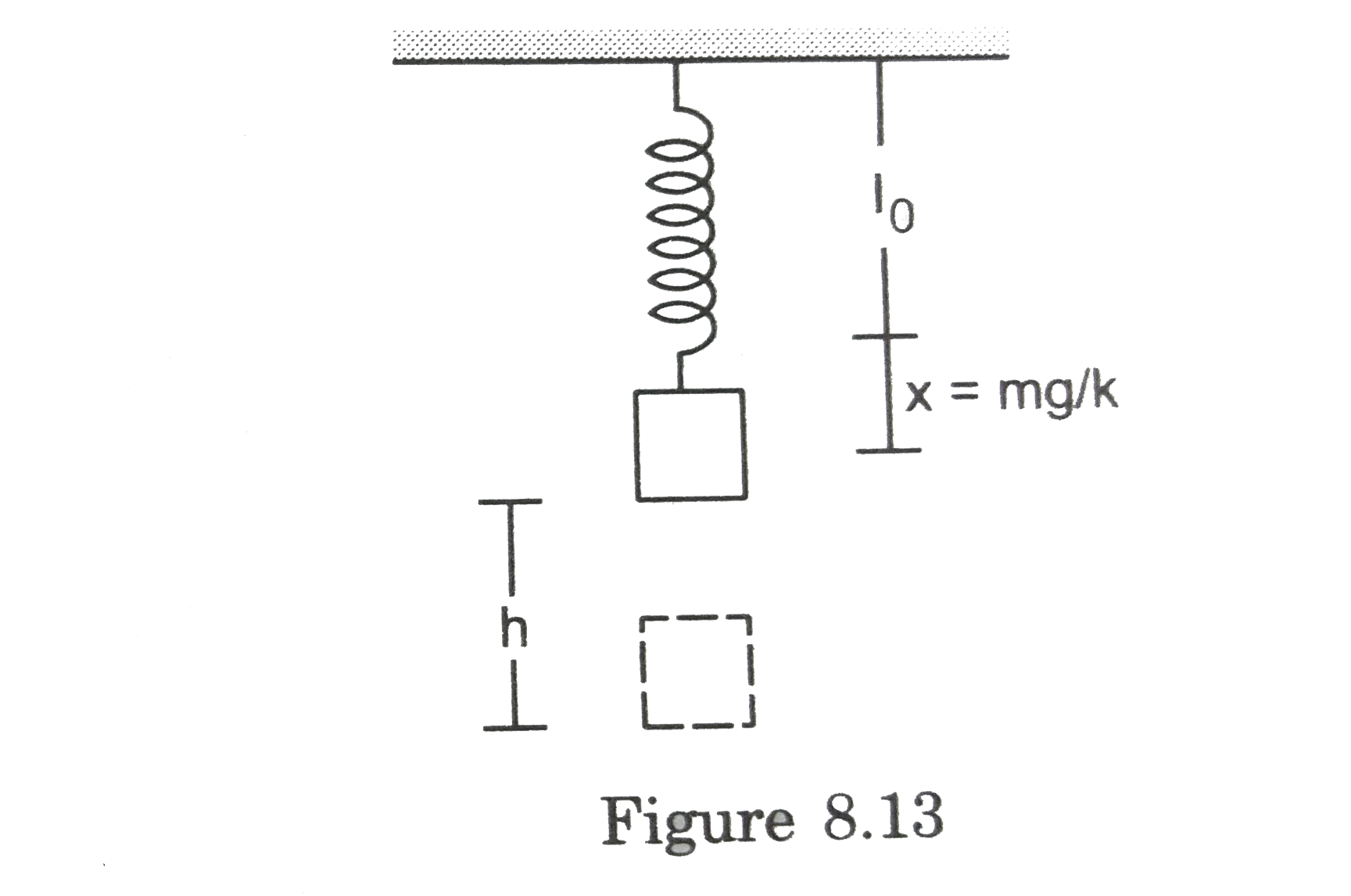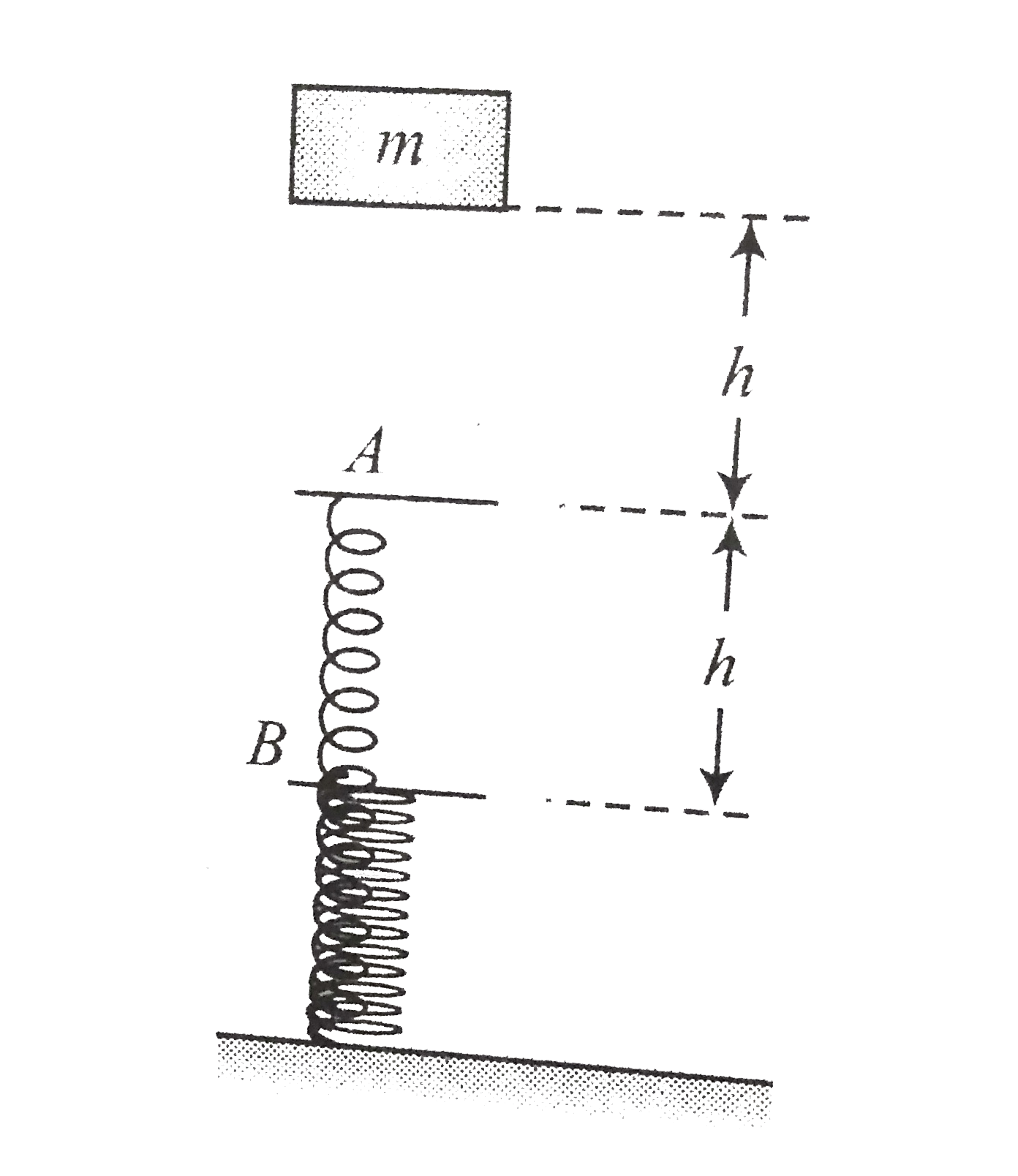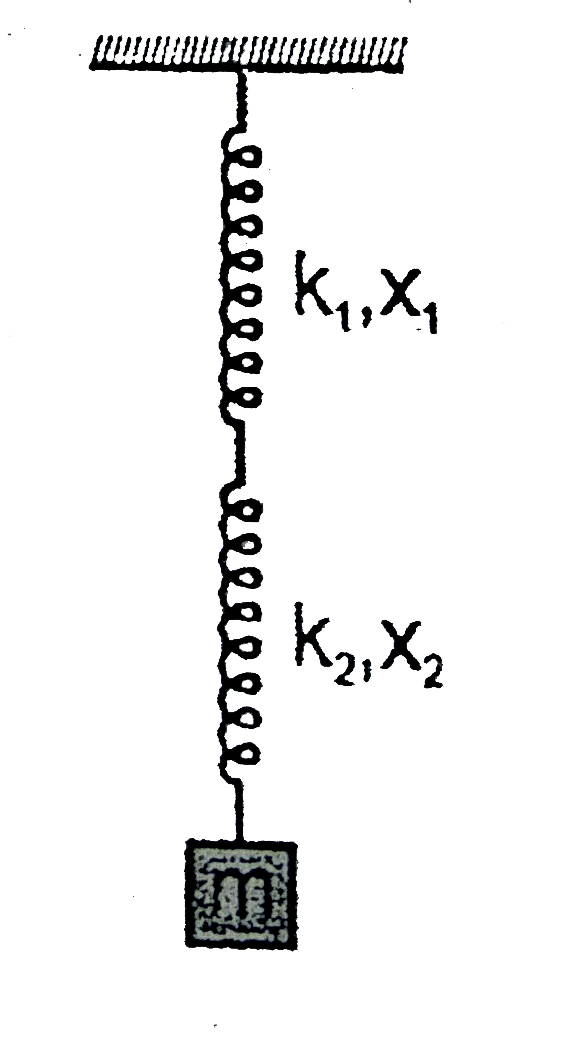A block of mass m is suspended through a spring of spring constant k and is in equilibrium. A sharp blow gives the block an initial downward velocity v. How far below the equilibrium position, the block comes to an instantaneous rest?Solution in Tamil
Klet us consider the blockthe spring+the earth as the system. The system has gravitatioN/Al potential energy corresponding to the force between the block and the earth as well as the elastic potential energy corresponding to the sring force. The total mechanicla energy includes kinetic enegy, gravitatioN/Al potential energy and elastic potential energy.

When the block is in equilibrium it is acted upon by two forces, a. the force of gravity mg and b. the tension in the spring T−kx. where x is the elongation. For equilibrium, mg=kx, so that the spring is stretched by a length x=mgk.Thepotentiale≠rgyofthespr∈g∈thispositionis<br>1/2 k(mg/k)^2=(m^2g^2)/(2k)<br>TakethegravitatioNAlpotentiale≠rgy→bezero∈thisposition..The→talmechaniclae≠rgyofthesystemjustaftertheblowis<br>1/2 mv^2+(m^2g^2)/(2k)<br>TheonlyexterNAlforceonthissystemistˆdue→the⌈∈⌉gwhichdoesnowork.Hence,themechanicale≠rgyothissystemrema∈sconstant.Iftheblockdescendsthroughaheighthbeforecomingbecomes<br>1/2k9mg/k+h)^2andthegravitatioNAlpotentiale≠rgy−mgh.thek∈etice≠rgyiszeroisthisstate.Thuswehave<br>1/2mv^2+(m^2g^2)/(2k)=1/2k(mg/k+h)^2-mgh<br>Solv∈gthiswe≥t,<br>h=vsqrt(m/k)
Compare this with the result obtained in example. If we neglect gravity and consider the length of the spring in equilibrium position as the N/Atural length, the answer is same. This simplication is often used while dealing with vertical springs.
Topper's Solved these Questions
- WORK AND ENERGYBOOK - HC VERMACHAPTER - WORK AND ENERGYEXERCISE - Worked out Examples
14 Videos
- WORK AND ENERGYBOOK - HC VERMACHAPTER - WORK AND ENERGYEXERCISE - Question for Short Answer
17 Videos
- WAVE MOTION AND WAVES ON A STRINGBOOK - HC VERMACHAPTER - WAVE MOTION AND WAVES ON A STRINGEXERCISE - Exercises
57 Videos
Similar Questions
A porter lifts a suitcase weighing 20 kg from the platform and puts it on his head 2.0 m above the platform. Calculate the work done by the porter on the suitcase.
View SolutionWhen you lift a box from the floor and put it one an almirah the ptotential energy of the box increases, but thre is no change in its kinetic energy. Is it a violation of consevation of energy?
View SolutionA wave pulse passing on a string with speed of 40cms−1 in the negative x direction has its maximum at x=0 at t=0. Where will this maximum be located at t=5s?
View SolutionA block of mass m is connect to another block of mass M by a massless spring of spring constant k. The blocks are kept on a smooth horizontal plane. Initially the blocks are at rest and the spring is unsrtretched when a constnt force F starts acting on the block of mass M to pull it. Find the maximum extension of the spring.

View SolutionA block of mass m is connected to another block of mass M by a spring (massless) of spring constant k. The block are kept on a smooth horizontal plane. Initially the blocks are at rest and the spring is unstretched. Then a constant force F starts acting on the block of mass M to pull it. Find the force of the block of mass M.
View SolutionA block of mass m is released from rest onto a spring. A having stiffness kA=mg/2h as shown in figure. If the block compresses spring B through a distance h, find the:

a. stiffness of the spring B
b. equilibrium position of the block
c. maximum velocity of the block
d. maximum acceleration of the block
View SolutionTwo springs are in a series combination and are attached to a block of mass 'm' which is in equilibrium. The spring constants and extension in the springs are as shown in the figure. Then the force exerted by the spring on the block is :

View SolutionA block of mass 'm' is connected to another block of mass 'M' by a spring (massless) of spring constant 'k' The blocks are kept on a smooth horizontal plane. Initially the blocks are at rest and the spring is unstretched Then a constant force 'F' starts acting on the block of mass 'M' to pull it. Find the force on the block of mass 'm' :
View SolutionA block of mass m, lying on a smooth horizontal surface, is attached to a spring (of negligible mass) of spring constant k. The other end of the spring is fixed, as shown in the figure. The block is initally at rest in its equilibrium position. If now the block is pulled withe a constant force F, the maximum speed of the block is :

View SolutionA block of mass m, lying on a smooth horizontal surface, is attached to a spring (of negligible mass) of spring constant k. The other end of the spring is fixed, as shown in the figure. The block is initally at rest in its equilibrium position. If now the block is pulled withe a constant force F, the maximum speed of the block is :
View SolutionA block of mass 'm' is connected to another block of mass 'M' by a spring (massless) of spring constant 'k'. The blocks are kept on a smooth horizontal plane. Initially the blocks are at rest and the spring is unstretched. Then a constant force 'F' starts acting on the block of mass 'M' to pull it. Find the force on the block of mass 'm'.
View SolutionA block of mass m is connected to another block of mass M by a spring (massless) of spring constant k. The blocks are kept on a smooth horizontal plane. Initially the blocks are at rest and the spring is unstretched. Then a constant force F starts acting on the block of mass M to pull it. Find the force on the block of mass m.
View SolutionA block of mass m is connected to another block of mass M by a spring (massless) of spring constant k. The blocks are kept on a smooth horizontal plane. Initially the blocks are at rest and the spring is unstretched. Then a constant force F starts acting on the block of mass M to pull it. Find the force on the block of mass m
View SolutionA block of mass m is connect to another block of mass M by a massless spring of spring constant k. The blocks are kept on a smooth horizontal plane. Initially the blocks are at rest and the spring is unsrtretched when a constnt force F starts acting on the block of mass M to pull it. Find the maximum extension of the spring.

View SolutionA block of mass m, lying on a smooth horizontal surface, is attached to a spring (of negligible mass) of spring constant k. The other end of the spring is fixed, as shown in the figure. The block is initally at rest in its equilibrium position. If now the block is pulled withe a constant force F, the maximum speed of the block is :

View SolutionA block of mass m is connected to another block of mass M by a massless spring of spring constant k. The blocks are kept on a smooth horizontal plane. Initially, the blocks are at rest and the spring is unstretched when a constant force F starts acting on the block of mass M to pull it. Find the maximum extension of the spring.

View Solution
